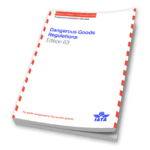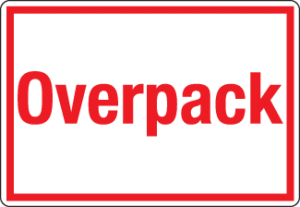This post was originally published in November 2017 and has been updated in May 2022 for accuracy.
Regulatory Helpdesk: November 20, 2017
Welcome back to the Regulatory Helpdesk where we answer your dangerous goods & hazmat questions. Here are some highlights from our helpdesk last week. Check back weekly, the helpdesk rarely hears the same question twice.
Overpacks
- Q. My shipment was refused even though I followed what the regulations and my training said for shipping an overpack. My drums were on a pallet and shrink wrapped. All of the information on the drums could be seen. I placed a sticker with the words “Overpack Used” on the shrink wrap and listed it that way on my paperwork. Can you tell me why my carrier refused it?
- A. Per Section 7.1.7 the actual wording that must be used on your pallet is just the word “overpack”. It seems confusing to have different terminology used but that is how the regulations work and why you should be trained every 2 years for IATA.
Using Combustible Liquid, N.O.S. (USA)
- Q. Since this product meets the combustible definition, can we use ‘NA1993 Combustible Liquids, n.o.s.’ to ship to Canada or does Canada only recognize the ‘UN1993 Flammable Liquids, n.o.s.’?
- A. Basically, to me, she is asking what is the difference between NA1993 and UN1993 and how it impacts transporting into Canada. NA1993 is a US only identification number. It is used for transporting combustible liquids in the US. Technically, a combustible liquid is NOT a Class 3 Flammable liquid because the flashpoints are too high to meet the classification criteria of regular Class 3 Liquids.
UN1993 is a United Nations number that is recognized worldwide and is used for liquids that meet the criteria of Class 3 Flammable liquids in 173.120 and their packing groups in 173.121.
DOT puts information about Combustible Liquids under the Flammable Liquids headings because they are liquids with vapors that burn just at temperatures beyond the criteria for a normal flammable liquid. Combustible liquids are only regulated in the US if they are in bulk packages which are containers that are designed to hold over 119 gallons.
A true combustible liquid under NA1993 for DOT would not be regulated in Canada because it does not meet the Flammable Liquid criteria in the Transport of Dangerous Goods regulations in Canada in Sections 2.18 and 2.19.
Packaging Excepted Quantities
- Q. A customer called in asking if he needs UN Specification packaging if he is shipping 100 milligrams of UN2811 (Toxic solid, organic, n.o.s.) PG II by air?
- A. If the customer is shipping under 1 gram, like in this case, UN Spec packaging is not a requirement as it can be shipped as an excepted quantity per the IATA table 2.6.A
Classification of Corrosives
- Q. Can the pH of a solution containing a “named” corrosive be excluded from a Class 8 classification based on a pH between 2-11?
- A. Not recommended. Despite the use of pH as a guideline for further in vitro or in vivo testing, cited UN- sanctioned criteria do not support pH alone as a criteria. This is particularly true for a “negative” classification since other factors (such as buffering capacity, synergistic effects of ingredients or properties of organic chemicals) can result in tissue corrosion despite the measured pH.
Segregation of Chemicals (Canada)
- Q. Are there requirements to separate certain dangerous goods despite the lack of a either segregation chart (Canadian TDG) or an indication of mandatory separation (e.g. Class 8) in regulations with a chart?
- A. Yes, regulations, with or without a chart, have a general requirement prohibiting the combination of DG in a way that may lead to a hazardous reaction or other danger to the public. It is always wise to check the SDS or other reference material when preparing shipments. For example TDG cites standard TP 14850, which indicates in §12.8.9 that goods that could react shall not be packaged together or within the same overpack. An example, which periodically leads to tragic results in the “service” industry, is mixing bleach (sodium hypochlorite solution)- a Class 8, with hydrochloric acid- also a Class 8 – which generates chlorine gas.
Here are some links that help illustrate this answer:
https://www.theglobeandmail.com/news/national/school-board-fined-in-death-of-custodian/article974850/Stay up to date and sign up for our newsletter!
We have all the products, services and training you need to ensure your staff is properly trained and informed.

IATA Publications
Shipping Dangerous Goods by Air Training Courses
Overpack Label, 4″ x 2.75″, Gloss Paper, 500/Roll






